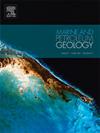Submarine morphology offshore Crotone (Calabrian accretionary prism, Central Mediterranean): Pockmark fields and mud extrusion in a mobile shale domain
IF 3.6
2区 地球科学
Q1 GEOSCIENCES, MULTIDISCIPLINARY
引用次数: 0
Abstract
The narrow Calabrian Arc accretionary prism, in the Mediterranean Sea, is known to be populated by mud volcanoes, although only a few of them have been extensively documented. The Ionian Sea offshore the Crotone Promontory offers examples where the expressions of fluid expulsion and sediment mobilization are visible both in the subsurface and at the seafloor. The analysis of a proprietary 3D seismic data cube allows characterization of pockmark patterns and identification of a mud diapir, which appears at the seafloor as a large mud pool, ca. 1200 m in diameter. The high resolution 3D seismic profiles allow differences to be inferred about the mechanisms of fluid focusing at very shallow sub-seafloor depths. Fluid focusing and pockmark formation are aided by normal faults arising from both outer arc extension and dilation in shallow unconsolidated sediments influenced by sharp increases in slope gradient. In some instances, it can be shown that fluid venting also contributed to destabilizing the uppermost sedimentary strata, triggering small landslides along the slope. The mud diapir has apparently been mobilized along an extensional fault, which tapped into a mobile shale domain. A fossil mud pool has also been recognized in the study area. This fossil mud pool is sealed by undeformed sedimentary strata which constrains a minimum age for fluid and sediment mobilization in the accretionary prism. Seismic reflection amplitudes suggest that the fossil conduit still acts as a preferential fluid seepage pathway, contributing to destabilization of the overlying slope sediments.
克罗托内近海海底形态(地中海中部卡拉布里亚增生棱镜):活动页岩域的麻坑田和泥挤压
位于地中海的狭窄的卡拉布里亚弧(Calabrian Arc)是众所周知的泥火山聚集地,尽管只有少数泥火山被广泛记录在案。克罗托内海附近的爱奥尼亚海就是一个例子,在那里流体排出和沉积物动员的表现在地下和海底都是可见的。通过对专有的三维地震数据立方体的分析,可以表征凹坑模式并识别泥底辟,泥底辟在海底表现为一个直径约1200米的大型泥池。高分辨率三维地震剖面可以推断出海底极浅深度流体聚焦机制的差异。浅层松散沉积层受斜坡坡度急剧增大的影响,由外弧伸展和扩张引起的正断层有助于流体聚焦和麻坑的形成。在某些情况下,可以证明流体喷发也有助于破坏最上层沉积地层的稳定,引发沿坡的小型滑坡。泥底辟显然是沿着一条伸展断裂被动员起来的,这条断裂进入了一个活动的页岩域。研究区还发现了古泥塘。这个化石泥池被未变形的沉积地层所封闭,这限制了在增生棱镜中流体和沉积物动员的最小年龄。地震反射振幅表明,化石管道仍然是一个优先的流体渗流通道,有助于上覆斜坡沉积物的失稳。
本文章由计算机程序翻译,如有差异,请以英文原文为准。
求助全文
约1分钟内获得全文
求助全文
来源期刊

Marine and Petroleum Geology
地学-地球科学综合
CiteScore
8.80
自引率
14.30%
发文量
475
审稿时长
63 days
期刊介绍:
Marine and Petroleum Geology is the pre-eminent international forum for the exchange of multidisciplinary concepts, interpretations and techniques for all concerned with marine and petroleum geology in industry, government and academia. Rapid bimonthly publication allows early communications of papers or short communications to the geoscience community.
Marine and Petroleum Geology is essential reading for geologists, geophysicists and explorationists in industry, government and academia working in the following areas: marine geology; basin analysis and evaluation; organic geochemistry; reserve/resource estimation; seismic stratigraphy; thermal models of basic evolution; sedimentary geology; continental margins; geophysical interpretation; structural geology/tectonics; formation evaluation techniques; well logging.
 求助内容:
求助内容: 应助结果提醒方式:
应助结果提醒方式:


